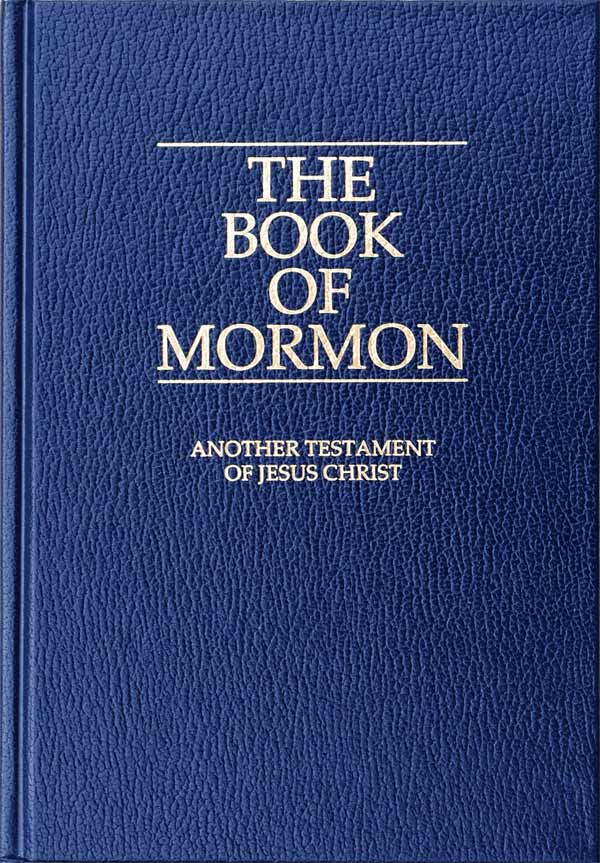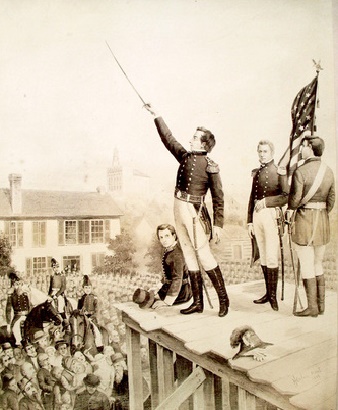|
Penalty (Mormon)
In Mormonism, a penalty was an oath made by participants of the original Nauvoo endowment ceremony instituted by Joseph Smith in 1843 and further developed by Brigham Young after Smith's death. Mormon critics refer to the penalty as a "blood oath," because it required the participant to swear never to reveal certain key symbols of the endowment ceremony, including the penalty itself, while symbolically enacting ways in which a person may be executed. The penalties were similar to oaths made as part of a particular rite of Freemasonry practiced in western New York at the time the endowment was developed. During the 20th century, The Church of Jesus Christ of Latter-day Saints (LDS Church) gradually softened the graphic nature of the penalties, and in 1990, removed them altogether from its version of the ceremony. Original oaths On May 4, 1842, Joseph Smith instituted the endowment ritual in Nauvoo, Illinois. At three different stages of the endowment, participants were asked to ta ... [...More Info...] [...Related Items...] OR: [Wikipedia] [Google] [Baidu] |
Mormonism
Mormonism is the religious tradition and theology of the Latter Day Saint movement of Restorationist Christianity started by Joseph Smith in Western New York in the 1820s and 1830s. As a label, Mormonism has been applied to various aspects of the Latter Day Saint movement, although there has been a recent push from the Church of Jesus Christ of Latter-day Saints (LDS Church) to distance themselves from this label. A historian, Sydney E. Ahlstrom, wrote in 1982, "One cannot even be sure, whether ormonismis a sect, a mystery cult, a new religion, a church, a people, a nation, or an American subculture; indeed, at different times and places it is all of these." However, scholars and theologians within the Latter Day Saint movement, including Smith, have often used "Mormonism" to describe the unique teachings and doctrines of the movement. A prominent feature of Mormon theology is the Book of Mormon, which describes itself as a chronicle of early indigenous peoples of the Americas ... [...More Info...] [...Related Items...] OR: [Wikipedia] [Google] [Baidu] |
Good Neighbor Policy (LDS Church)
The Good Neighbor policy is the 1927 reform of the Church of Jesus Christ of Latter-day Saints (LDS Church) that removed any suggestion in church literature, sermons, and ordinances that its members should seek vengeance on US citizens or governments, particularly for the assassinations of its founder Joseph Smith and his brother, Hyrum. The church gave no official name to this process, but after it was implemented, some Mormon-history commentators began referring to it as the church's "Good Neighbor" policy, taking the name from US President Franklin Roosevelt's foreign policy, the Good Neighbor policy. Changes in temple ordinances In 1919, shortly after he became the president of the LDS Church, Heber J. Grant appointed a committee to review the content of ordinances performed in LDS Church temples. The committee completed its work in 1927 and recommended to Grant that the oath of vengeance be removed from the temple endowment ceremony. The oath of vengeance required particip ... [...More Info...] [...Related Items...] OR: [Wikipedia] [Google] [Baidu] |
Latter Day Saint Terms
{{Short pages monitor ... [...More Info...] [...Related Items...] OR: [Wikipedia] [Google] [Baidu] |
Punishments In Religion
Punishment, commonly, is the imposition of an undesirable or unpleasant outcome upon a group or individual, meted out by an authority—in contexts ranging from child discipline to criminal law—as a response and deterrent to a particular action or behavior that is deemed undesirable or unacceptable. It is, however, possible to distinguish between various different understandings of what punishment is. The reasoning for punishment may be to condition a child to avoid self-endangerment, to impose social conformity (in particular, in the contexts of compulsory education or military discipline), to defend norms, to protect against future harms (in particular, those from violent crime), and to maintain the law—and respect for rule of law—under which the social group is governed. and violates the law or rules by which the group is governed. Punishment may be self-inflicted as with self-flagellation and mortification of the flesh in the religious setting, but is ... [...More Info...] [...Related Items...] OR: [Wikipedia] [Google] [Baidu] |
Religious Oaths
Religion is usually defined as a social-cultural system of designated behaviors and practices, morals, beliefs, worldviews, texts, sanctified places, prophecies, ethics, or organizations, that generally relates humanity to supernatural, transcendental, and spiritual elements; however, there is no scholarly consensus over what precisely constitutes a religion. Different religions may or may not contain various elements ranging from the divine, sacred things, faith,Tillich, P. (1957) ''Dynamics of faith''. Harper Perennial; (p. 1). a supernatural being or supernatural beings or "some sort of ultimacy and transcendence that will provide norms and power for the rest of life". Religious practices may include rituals, sermons, commemoration or veneration (of deities or saints), sacrifices, festivals, feasts, trances, initiations, funerary services, matrimonial services, meditation, prayer, music, art, dance, public service, or other aspects of human culture. Religions have sa ... [...More Info...] [...Related Items...] OR: [Wikipedia] [Google] [Baidu] |
Latter Day Saint Temple Practices
{{Short pages monitor ... [...More Info...] [...Related Items...] OR: [Wikipedia] [Google] [Baidu] |
History Of The Church Of Jesus Christ Of Latter-day Saints {{R from other capitalisation ...
#REDIRECT History of the Church of Jesus Christ of Latter-day Saints #REDIRECT History of the Church of Jesus Christ of Latter-day Saints {{R from other capitalisation ... [...More Info...] [...Related Items...] OR: [Wikipedia] [Google] [Baidu] |
Criticism Of Mormonism
Criticism is the construction of a judgement about the negative qualities of someone or something. Criticism can range from impromptu comments to a written detailed response. , ''"the act of giving your opinion or judgment about the good or bad qualities of something or someone or the act of saying that something or someone is bad'' Criticism falls into several overlapping types including "theoretical, practical, impressionistic, affective, prescriptive, or descriptive". , ''"The reasoned discussion of literary works, an activity which may include some or all of the following procedures, in varying proportions: the defence of literature against moralists and censors, classification of a work according to its genre, interpretation of its meaning, analysis of its structure and style, judgement of its worth by comparison with other works, estimation of its likely effect on readers, and the establishment of general principles by which literary works can be evaluated and understood."'' ... [...More Info...] [...Related Items...] OR: [Wikipedia] [Google] [Baidu] |
Mormonism And Violence
Mormons have both used and been subjected to significant violence throughout much of the religion's history. In the early history of the United States, violence was used as a form of control. Mormons were violently persecuted and pushed from Ohio to Missouri, from Missouri to Illinois and from Illinois, they were pushed west to the Utah Territory. There were incidents of massacre, home burning and pillaging, followed by the death of their prophet, Joseph Smith. Smith died from multiple gunshot wounds from a lynch mob at a jail in Carthage, Illinois; Smith had defended himself with a small pistol smuggled to him by church leader Cyrus Wheelock and he was then shot while trying to flee from a window. There were also notable incidents in which Mormons perpetrated violence. Under the direction of Mormon prophets and apostles, the Mormon burned and looted Davies County, attacked and killed a member of the Missouri state militia, and carried out an extermination order on the Timpa ... [...More Info...] [...Related Items...] OR: [Wikipedia] [Google] [Baidu] |
True And Living Church Of Jesus Christ Of Saints Of The Last Days
The True and Living Church of Jesus Christ of Saints of the Last Days (TLC) is a breakaway sect of the Church of Jesus Christ of Latter-day Saints (LDS Church). It is headquartered in Manti, Utah, United States, where as of 2004 it maintained a membership of 300 to 500 adherents. The church maintains a meetinghouse in downtown Manti, and in the past also owned the Red Brick Store, also downtown. Establishment left, 150px, The church was organized on May 3, 1994, in response to what was felt to be a general apostasy of the LDS Church. This apostasy included Brigham Young (and subsequent presidents of the LDS Church) scattering the LDS Church membership rather than gathering it; the discontinuation of plural marriage; changes to ordinances and temple-related doctrine; and an increasing trend of what TLC describes as "watering-down" doctrine. The TLC began as a study group and Priesthood Council in the early 1990s, where people from both the LDS Church and Mormon fundamentalist ... [...More Info...] [...Related Items...] OR: [Wikipedia] [Google] [Baidu] |
Apostolic United Brethren
The Apostolic United Brethren (AUB) is a Mormon fundamentalist group that practices polygamy. The AUB has had a temple in Mexico, since at least the 1990s, an endowment house in Utah since the early 1980s and several other locations of worship to accommodate their members in Wyoming, Idaho, and Montana. The title "Apostolic United Brethren" is not generally used by members, who prefer to call it "The Work", "The Priesthood", or "The Group". Those outside the faith sometimes refer to it as the "Allred Group" because two of its presidents shared that surname. Members of the AUB do not refer to their organization as a "church" and, unlike nearly all other Mormon fundamentalist groups, regard the Church of Jesus Christ of Latter-day Saints (LDS Church) as a legitimate, if wayward and diminished, divine institution. Religious scholar J. Gordon Melton characterised the group as "the more liberal branch of the Fundamentalist movement", as the group allows sexual relations apart from ... [...More Info...] [...Related Items...] OR: [Wikipedia] [Google] [Baidu] |
Fundamentalist Church Of Jesus Christ Of Latter-Day Saints
The Fundamentalist Church of Jesus Christ of Latter-Day Saints (FLDS Church) is a religious sect of the fundamentalist Mormon denominations whose members practice polygamy. The fundamentalist Mormon movement emerged in the early 20th century, when its founding members were excommunicated from the Church of Jesus Christ of Latter-day Saints (LDS Church), largely because of their refusal to abandon the practice of plural marriage after it was renounced in the " Second Manifesto" (1904). The FLDS Church as a distinct group traces its origins to the 1950s in the Short Creek community (now the twin cities of Hildale, Utah and Colorado City, Arizona), where the group is still based. The FLDS Church has been designated as a hate group by the Southern Poverty Law Center: citing leader Warren Jeffs' opinions on "Blacks, women, gays, violence and the end of the world"; and called them "a white supremacist, homophobic, antigovernment, totalitarian cult". The group is considered a pol ... [...More Info...] [...Related Items...] OR: [Wikipedia] [Google] [Baidu] |




